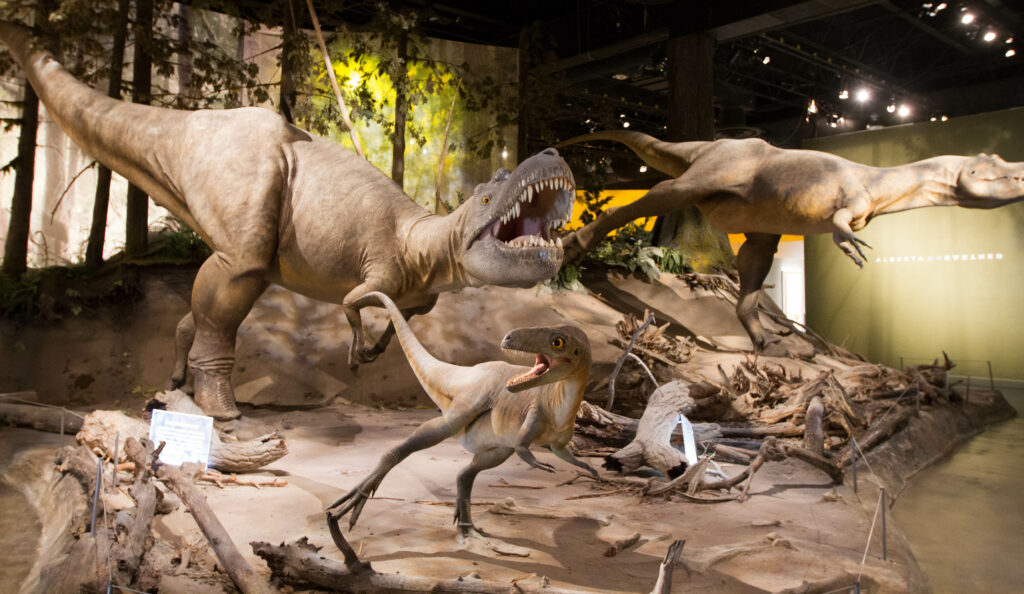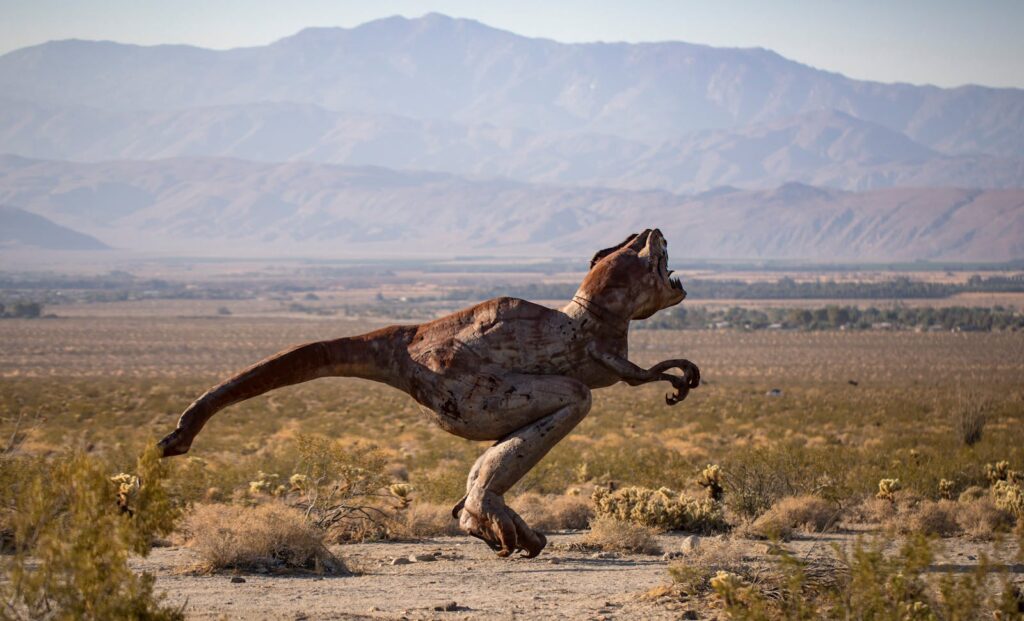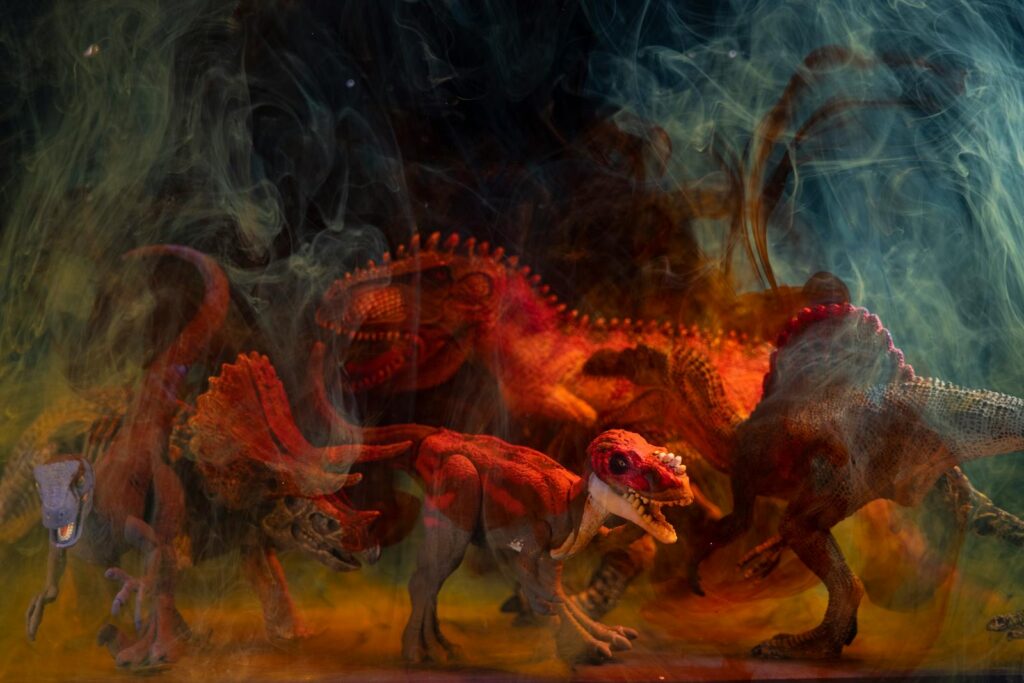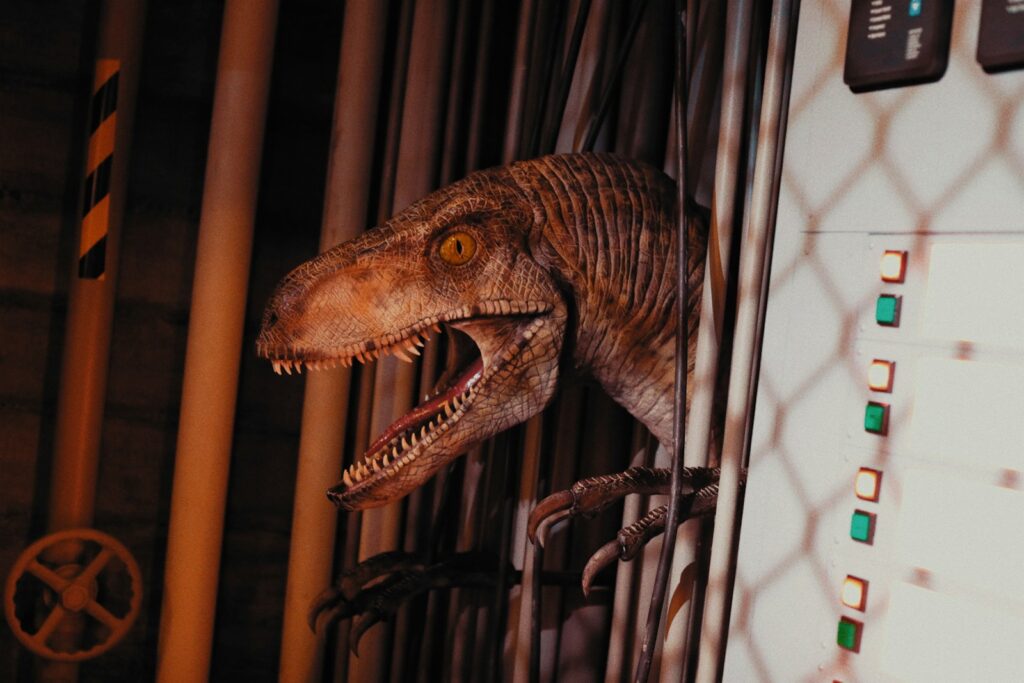Dinosaurs have captivated human imagination since their fossils were first discovered, and their presence in video games has evolved dramatically over the decades. From pixelated predators to scientifically accurate digital recreations, these prehistoric creatures have stomped, roared, and evolved across gaming platforms since the earliest days of the medium. The portrayal of dinosaurs in video games reflects not only advances in technology but also shifts in scientific understanding and popular culture’s fascination with these magnificent extinct animals. This article explores the fascinating journey of dinosaur representation in video games, from simple arcade experiences to complex modern simulations that bring these ancient beasts to virtual life.
The Early Days: Primitive Pixels and Arcade Adaptations

The earliest dinosaur appearances in video games were necessarily limited by the technology of the late 1970s and early 1980s. Games like Taito’s 1982 arcade title “Jungle King” (later renamed “Jungle Hunt”) featured simplistic dinosaur-like creatures as obstacles for players to overcome. These early representations were often little more than blocky silhouettes, bearing only a passing resemblance to actual dinosaurs. Another early example came with Exidy’s 1983 arcade game “Crossbow,” which included dinosaurs among its various targets. These primitive depictions relied heavily on player imagination, as the limited pixel count and color palette of the era made detailed representation impossible. Despite these technical constraints, these games established dinosaurs as exciting antagonists in the gaming world, setting the stage for more sophisticated depictions as technology advanced.
Dinosaurs as Playable Characters: A New Perspective

As video game technology evolved through the mid-1980s, an interesting shift occurred when developers began casting dinosaurs as playable characters rather than merely obstacles or enemies. Hudson Soft’s “Adventure Island” series featured a skateboarding dinosaur companion, while Rare’s 1994 release “Dinosaur Discovery” for the Super Nintendo allowed players to control various dinosaur species. Perhaps the most memorable early playable dinosaur was Yoshi, who debuted in “Super Mario World” (1990) before starring in his own series of games. These titles marked an important transition in how dinosaurs were portrayed in games, shifting from threatening predators to companions or heroes. By allowing players to inhabit dinosaur characters, these games created a more sympathetic connection to prehistoric creatures and expanded their roles beyond the simple “monster” archetype that had previously dominated. This period established dinosaurs as versatile character types that could fill numerous roles in game narratives.
The Jurassic Park Effect: Movie Tie-ins Transform Dinosaur Games

The 1993 release of Steven Spielberg’s “Jurassic Park” film revolutionized dinosaur representation across all media, including video games. The film’s groundbreaking special effects created new expectations for realistic dinosaur portrayals, and numerous game adaptations followed across virtually every gaming platform of the era. Ocean Software’s “Jurassic Park” games for the SNES and Genesis offered different gameplay styles—the Genesis version allowed players to control a Velociraptor, while the SNES version cast players as Dr. Grant. These games attempted to capture the film’s tension and spectacle, though technical limitations still constrained their realism. The influence of “Jurassic Park” extended beyond direct adaptations, raising the bar for dinosaur representation in all games that followed. Games began incorporating more scientifically accurate models based on contemporary paleontological findings, moving away from the outdated tail-dragging depictions of earlier decades. This film franchise continues to influence dinosaur games today, establishing many of the visual and behavioral standards that players expect from digital dinosaurs.
Dinosaur Survival Horror: When Prehistoric Meets Terror

The late 1990s and early 2000s saw developers exploring the terrifying aspects of dinosaurs through the lens of survival horror. Capcom’s “Dino Crisis” series, first released in 1999, applied the successful “Resident Evil” formula to dinosaurs instead of zombies. Created by Shinji Mikami, “Dino Crisis” featured protagonist Regina navigating a research facility overrun by genetically engineered dinosaurs. These games emphasized the predatory nature of dinosaurs, particularly Velociraptors and Tyrannosaurus rex, portraying them as intelligent hunters that stalked players through claustrophobic environments. The sound design was particularly noteworthy, with realistic roars and footsteps creating a sense of dread even when dinosaurs weren’t visible on screen. While scientific accuracy was secondary to creating fear, these games nonetheless reflected contemporary understanding of dinosaurs as active, warm-blooded predators rather than slow, lumbering reptiles. The survival horror approach emphasized dinosaurs’ alien nature and predatory capabilities, reinforcing their status as both fascinating and terrifying creatures in gaming contexts.
Educational Approaches: Learning Through Digital Dinosaurs

Not all dinosaur games focused on action or horror; many developers recognized the educational potential of these prehistoric creatures. Throughout the 1990s and beyond, a substantial market emerged for games that combined entertainment with paleontological education. Titles like “DinoPark Tycoon” (1993) taught players about dinosaur care and exhibition while offering business simulation gameplay. “3D Dinosaur Adventure” by Knowledge Adventure became a staple in many school computer labs, offering encyclopedic information alongside simple games. These educational titles often featured more scientifically accurate depictions than their action-oriented counterparts, incorporating the latest research into their designs and descriptions. By balancing entertainment with education, these games served as entry points for many young dinosaur enthusiasts, who could learn about prehistoric periods, fossil discovery, and dinosaur biology while playing. The educational dinosaur game tradition continues today with titles like “Dinosaur Discovery” and various museum-developed apps that use gaming mechanics to facilitate learning about paleontology.
Open World Dinosaur Experiences: Freedom to Explore Prehistoric Settings

The advent of more powerful gaming hardware in the 2000s enabled developers to create expansive open-world environments where dinosaurs could roam freely. Trespasser (1998), despite its technical flaws, pioneered this approach as an ambitious “Jurassic Park” tie-in that placed players in an open island environment populated by dynamically behaving dinosaurs. More successful implementations followed, with titles like “Turok: Dinosaur Hunter” offering expansive prehistoric worlds to explore. These open-world dinosaur games emphasized environmental storytelling and emergent gameplay, allowing players to encounter dinosaurs in more natural contexts rather than purely scripted sequences. The increased processing power allowed for more realistic dinosaur behaviors, including herd dynamics, territorial disputes, and hunting patterns. Games like “Saurian” took this approach further by attempting to recreate accurate prehistoric ecosystems where players could experience life as a dinosaur within scientifically plausible settings. These titles transformed dinosaurs from mere opponents or obstacles into integral parts of living, breathing virtual worlds that players could freely explore and observe.
The Rise of Dinosaur Survival Games: ARK and Its Contemporaries

The survival game genre exploded in popularity during the 2010s, and dinosaurs found a natural home in this emerging gameplay style. Studio Wildcard’s “ARK: Survival Evolved” (2017) became the definitive dinosaur survival experience, placing players in a hostile world where dinosaurs and other prehistoric creatures could be fought, tamed, and ridden. ARK’s innovation was treating dinosaurs as resources and companions rather than just threats, allowing players to form bonds with their tamed creatures and use their abilities strategically. The game featured over 100 prehistoric species with distinct behaviors, abilities, and uses within its crafting and survival systems. ARK’s massive success spawned numerous competitors and imitators, including “PixARK,” “Durango,” and “The Stomping Land.” These games collectively established a new paradigm for dinosaur representation in games—one where dinosaurs were multifaceted entities that could serve as threats, tools, transportation, companions, and resources simultaneously. The survival genre’s emphasis on resource management and adaptation meshed perfectly with dinosaur settings, creating experiences where prehistoric creatures became central to gameplay mechanics rather than merely atmospheric additions.
Scientific Accuracy vs. Entertainment: The Ongoing Balancing Act

Throughout the evolution of dinosaur video games, developers have consistently faced the challenge of balancing scientific accuracy with entertainment value. Games like “Saurian” and “Prehistoric Kingdom” explicitly prioritize scientific accuracy, incorporating the latest paleontological research into their dinosaur designs and behaviors. These games feature feathered dinosaurs, accurately scaled body proportions, and behaviors based on current scientific understanding. In contrast, series like “Monster Hunter” take creative liberties with dinosaur-inspired creatures, creating fantastical versions that prioritize exciting gameplay over accuracy. Most dinosaur games fall somewhere in between these extremes, selecting which scientific details to include based on their impact on gameplay and visual appeal. Even scientifically minded games often include speculative elements where the fossil record is incomplete, particularly regarding coloration, vocalizations, and social behaviors. This tension between accuracy and entertainment reflects the broader cultural negotiation around dinosaur representation, as developers must decide whether their digital dinosaurs should reflect what science suggests these animals were actually like or what players expect and find exciting.
Virtual Reality Brings Dinosaurs to Life: A New Dimension of Immersion

The emergence of consumer virtual reality technology in the mid-2010s created unprecedented opportunities for immersive dinosaur encounters. VR dinosaur experiences like “Robinson: The Journey,” “Time of Dinosaurs,” and “Ark Park” allowed players to experience the scale and presence of dinosaurs in ways previously impossible. Standing beside a virtual Brachiosaurus in VR provides a sense of size and magnitude that traditional screen-based games cannot match, while being stalked by a Velociraptor creates a level of tension that becomes physically palpable. These VR experiences often emphasize observation and interaction over traditional gaming challenges, allowing players to study dinosaurs up close and appreciate details that might be missed in faster-paced games. Many VR dinosaur experiences are designed with an educational component, using the emotional impact of virtual presence to create memorable learning experiences about prehistoric life. As VR technology continues to advance, these dinosaur experiences grow increasingly sophisticated, with improved haptic feedback, more realistic dinosaur behaviors, and more detailed environments creating ever more convincing prehistoric encounters.
Dinosaur Simulation Games: Managing Prehistoric Parks and Ecosystems

Building on the foundation established by the film franchise, dinosaur park simulation games have become a prominent subgenre in dinosaur gaming. Frontier Developments’ “Jurassic World Evolution” series allows players to design, build, and manage their own dinosaur theme parks, dealing with everything from genomic research to visitor facilities while preventing inevitable dinosaur breakouts. These games emphasize the complex systems required to maintain artificial dinosaur habitats, challenging players to balance scientific research, entertainment value, and safety concerns. Beyond the Jurassic franchise, “Prehistoric Kingdom” offers a more scientifically grounded take on the dinosaur park simulator, featuring accurate dinosaur models and rigorous attention to paleontological detail. These simulation games typically feature deep management systems, allowing players to experience the theoretical challenges of maintaining dinosaur collections while learning about the needs and behaviors of different species. The popularity of these titles reflects the enduring public fascination with the concept of dinosaur parks, allowing players to test their own solutions to the problems dramatically portrayed in the Jurassic Park films.
Mobile Gaming: Bringing Dinosaurs to the Mainstream

The explosion of mobile gaming in the 2010s dramatically expanded the audience for dinosaur games, making prehistoric creatures accessible to casual gamers through smartphones and tablets. Simple but addictive games like “Dino Run” captured the imagination of mobile users with straightforward gameplay and charming dinosaur characters. Augmented reality applications like “Jurassic World Alive” allowed players to discover and collect virtual dinosaurs in their real-world surroundings, similar to “Pokémon GO” but with prehistoric creatures. Mobile platforms also saw numerous dinosaur-themed educational apps designed for children, combining simple games with factual information about prehistoric life. The free-to-play model prevalent in mobile gaming led to a proliferation of dinosaur-themed match-three puzzles, endless runners, and simple battle games that used dinosaurs primarily as attractive visual elements. While most mobile dinosaur games lack the depth and complexity of their console and PC counterparts, they have been instrumental in maintaining and broadening mainstream interest in dinosaurs, reaching audiences who might never play more dedicated dinosaur simulation or survival games.
The Future of Dinosaurs in Gaming: New Frontiers and Technologies

Looking ahead, several emerging technologies promise to transform dinosaur representation in games even further. Procedural animation systems are beginning to create more natural and variable dinosaur movements, moving beyond the canned animations of earlier games. Machine learning algorithms could potentially model complex dinosaur behaviors based on what we understand about both extinct animals and their modern relatives, creating more believable prehistoric ecosystems. Advances in real-time rendering continue to improve the visual fidelity of digital dinosaurs, with technologies like ray tracing allowing for more realistic lighting and shadows that enhance the believability of these creatures. Beyond technical advancements, future dinosaur games will likely continue to diversify in their approaches, from hyper-realistic simulators to fantastical adventures. The ongoing discoveries in paleontology will continue to influence game design, potentially introducing players to lesser-known dinosaur species and revised understandings of familiar ones. As gaming technology evolves, the dream of truly stepping into a living, breathing prehistoric world becomes increasingly attainable, promising ever more compelling digital dinosaur experiences for players in the coming years.
Cultural Impact: How Dinosaur Games Shape Public Perception

Video games have become a significant cultural force in shaping public understanding and perception of dinosaurs, particularly for younger generations. For many children, games now serve as their first and most memorable introduction to prehistoric life, creating lasting impressions that can spark lifelong interest in paleontology. Unlike passive media like books or films, games allow direct interaction with virtual dinosaurs, creating more personal and impactful experiences. This influence carries responsibilities for developers, as inaccurate portrayals can establish misconceptions that may persist despite later corrections. Some paleontologists and museums have recognized the educational potential of this medium, collaborating with developers to create games that entertain while communicating current scientific understanding. The Field Museum in Chicago, for instance, consulted on “Saurian” to ensure its dinosaurs reflected contemporary research. Games like “Jurassic World Evolution” include documentary content alongside gameplay, providing context and educational material about the creatures players encounter. As dinosaur games continue to evolve technically and creatively, their role in shaping public perception of prehistoric life will only grow more significant, highlighting the importance of thoughtful approaches to dinosaur representation in this interactive medium.
Conclusion

The evolution of dinosaurs in video games reflects a fascinating intersection of technological advancement, scientific discovery, and popular culture. From the primitive pixel predators of the 1980s to today’s behaviorally complex digital dinosaurs, these virtual recreations have grown increasingly sophisticated while serving diverse gameplay purposes. As game developers continue to push boundaries with new technologies and innovative game designs, digital dinosaurs will undoubtedly continue to evolve, bringing players ever closer to the dream of experiencing prehistoric life in all its wonder and complexity. Whether scientifically rigorous or fantastically reimagined, dinosaurs remain enduring figures in the gaming landscape, their continued popularity a testament to humanity’s unending fascination with these remarkable creatures that once ruled our planet.




